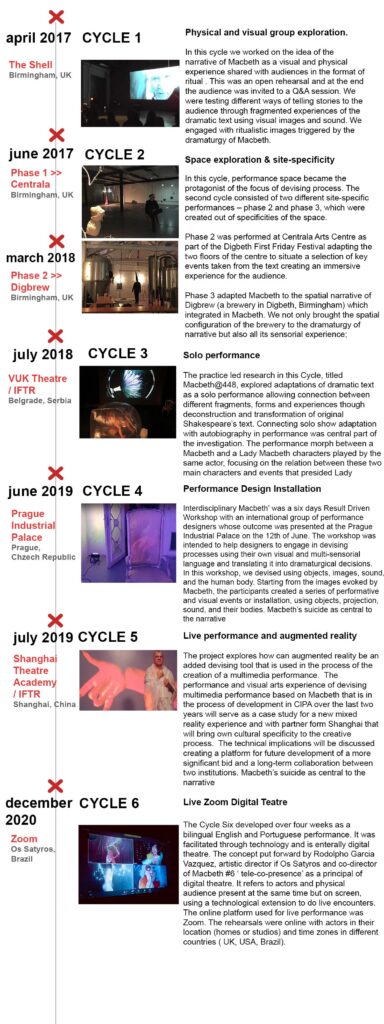Macbeth Projeto (2017-2020) is a collaborative performing arts project that used imagery and themes from Shakespeare’s Macbeth as a reference point for exploring different types of inter-media performativity. From the start, a fixed production objective was to create a collaborative performance with Teatro Os Satyros ( São Paulo) by the end of the process. The research question was ‘How can migration of the dramatic text (Shakespeare’s Macbeth), deconstruction and transformation of various theatrical forms create different aesthetic qualities and audience experiences through the use of creative performance and visual arts methodologies? The research project developed through six performance cycles, each of which experimented with devising strategies in order to adapt a dramatic text into a multi-sensorial performance. The project grew out of Aleksandar Dundjerovic’s ongoing research into contemporary Brazilian theatre. The main focus was to create new knowledge and understanding of interdisciplinary and anthropophagic performance. The new understanding of collaborative practices and performing arts in Brazil was published in two books – co-authored Brazilian Collaborative Theatre (2017) and co-edited Brazilian Performing Arts (2019). Shakespeare’s text was a starting point to devise novel methodologies that combined performance, visual arts and digital media with Brazilian creative, collaborative processes. The performance cycles were created through group improvisation following the Elizabethan (Shakespearean) approach to rehearsals. The RSVP/Repère and Viewpoints creative models explored different art forms: ritual and group theatre; site-specific, solo-performance, performance design installation, augmented reality and live Zoom digital theatre (created as a remote on-line devised performance). National and international collaborators and co-producers with the Centre for Interdisciplinary Performing Arts (CIPA) were Centrala Arts Centre and Digbrew (Birmingham, 2017); International Federation of Theatre Research (IFTR) and VUK Theatre (Belgrade, 2018); Prague Quadrennial of Performance Design (Prague, 2019), AHRC UK-China Creative Industries Partnership in Shanghai Theatre Academy (Shanghai, 2019), and finally as a live Zoom digital theatre with Teatro Os Satyros (Sao Paulo, 2020).
Research context
Devising method:
The principal influences on the devised interdisciplinary performance of Macbeth Projeto (April,2017-December, 2020) came from contemporary Brazilian devising performance. In 2008/09, Prof. Aleksandar Dundjerovic (PI) was awarded a Leverhulme Research Fellowship to research practice in Brazilian theatre devising. In addition, Dundjerovic has a long-established relationship with the School of Performing Arts at The University of Sao Paulo, where he has been a visiting Professor since 2007. His two books: co-authored Brazilian Collaborative Theatre (2017) and co-edited Brazilian Performing Arts (2019) were founded on his investigation into the diversity of performance models in the work of directors and group theatres in contemporary Brazil. In this creative research project, the philosophy of cultural anthropophagy – essential to Brazilian national theatre, particularly to the founding theatre director-author Ze Celso’s Teatro Oficina, underpinned the approach to performance practice research. Anthropophagy is rooted in 1920s Brazilian Modernism and the work of poet and playwright Oscar de Andrade. As an artistic philosophy, anthropophagy sought to establish a uniquely Brazilian culture founded on indigenous, African and non-European influences. In Brazilian theatre, the concepts of subjectivity, intercultural, otherness and hybridity are a consequence of the anthropophagic approach, of freely using arts and culture references and ‘eating’, cannibalising the best parts through own creative process.
In Brazil, Shakespeare’s opus has been linked to anthropophagy (Refskou, Amorium, and Carvalho, 2019) and, as a writer, he has unprecedented presence in the work of Brazilian directors and group theatre. Another important influence on the devising method of Macbeth Projeto was the actors-author approach that came from Robert Lepage (Repère Cycles) and Anne Bogart (Viewpoints). From the start, playing with imagery, context, subtext and inter-theatricality from Macbeth, as well as an understanding of the Elizabethan rehearsal process (Stern, 2008) informed our devising strategies. The ways in which the group of actors worked on the play during rehearsals, particularly using a scroll (as a score of an action plan) and making the group performance in a very short period of time, provided important guidance to our research process.
The number of cycles was not defined at the beginning of the process; rather, each cycle emerged from the previous one. The performance in Cycle 1 became a reference point for the development of Cycle 2 and so on. From Cycle 2, we positioned the character of Macbeth as the protagonist who is an entertainer, allowing him to shape events in his party, interacting with a participatory audience (invited to his feast to celebrate him becoming a King). Lady Macbeth’s character mediated through different cycles as a projection in a water bucket, contortionist, performed in a solo show by the same actor doing Macbeth, and as an augmented reality avatar was the main antagonist. The only other character from the play Macbeth was the ghost of Banquo that haunted Macbeth while he was entertaining his guests (audiences). In Cycle 6, in addition to the character of Macbeth, we focused on the creation of three different Lady Macbeths and the development of the characters of Duncan, Banquo, Witches, and Lady Macduff. Planning a collaboration with Brazilian Theatre Company Os Satyros was fixed from the beginning of the creative research process that would come at the end of our investigation in cycle#6.
An important part of the devising method came from the theatrical space and the transposition of the play’s text into the space. Using performing and visual arts to migrate the dramatic text required us to incorporate strategies from participatory audience, live digital performance, site–specific, installation, and immersive performance.
Research Objectives:
- To explore ways in which the devising process can be used to work on new interpretations of the text, particularly in relation to Shakespeare and his poetic imagery driven theatre.
- To use performing and visual arts to migrate the dramatic text into an interdisciplinary performative experience for the audience.
- To investigate the architecture of the performance as a location that creates spatial dramaturgies. There is not just a physical reality; spaces are linked to actions and events that provide them with a meaning beyond their configuration.
- To create a performance style actualizing the aesthetic qualities of Shakespeare’s text through an intermedial performance explored through multiple artistic forms, styles and media.
- To find a way to explore the hidden meanings in Shakespeare’s Macbeth through Brazilian collaborative creative and anthropophagic theatre.
- To develop new ways of understanding Shakespeare through mixed-authorship collaborative performance adaptations.
- To establish a relationship with the audience as participants (and creators) through immersive performativity in the theatre event.
- To develop a range of innovative research methods, methodologies and analytical techniques for the rehearsal process, using Shakespeare’s Macbeth as a key dramatic text.
Shakespeare’s Macbeth
The choice to work with Shakespeare’s Macbeth as a vehicle for investigation of rehearsal techniques and migration of the dramatic text into performance and visual arts was based on the play’s open structure, the relation with black culture and African traditions and imagery that provided provocation for exploration of the performance space.
Macbeth, the shortest, fastest moving and with strongest religious references, and presence of evil, of Shakespeare’s plays, was written between c.1603-1606. The play was probably performed for the first time in 1606, although eyewitness accounts place it in 1611 at the Globe Theatre. The First Folio in 1623 is the early printed text-based on theatre scrolls, with editing and revision “possibly by Thomas Middleton1. Shakespeare’s Macbeth is considered unfinished (or unrecorded). Its poetic structure was placed in a five-act dramaturgical structure after the 19th century. The text is based on a recording of a performance. The poetic images and themes could be seen as scores that could be developed through the actor-author approach. The structural openness of Macbeth allowed the appropriation of the collaborative creative process. Because of all these, It was suitable for the devising process using the RSVP/Repère method, Viewpoints and anthropophagic performativity.
Ever since Orson Welles’ production of ‘Voodoo Macbeth’ with an all-black cast in 1936 in New York’s Harlem, the text of Macbeth has provided connectivity with traditions that could bring different understandings as well as performative and aesthetic qualities to the interpretation of the play. Welles’ transposed Macbeth from Scotland (Shakespeare uses accounts to base his character on Raphael Holinshed’s Chronicles of England, Scotland and Ireland,1587 a popular history at his time) to an island resembling Haiti, using the supernatural and witches to connect with African traditions. We wanted to transpose Macbeth to the aestheticism of Brazilian black traditions and anthropophagic cultural influence.
Via the witches, Shakespeare takes us through a series of events linked to actions that are spatialized and performed within specific aesthetics. Macbeth allows us to recreate rituals from different cultures and create images with them. It is in the richness of the visual possibilities that Macbeth offers us what is behind the choice of this play. Shakespearean theatrical conventions are based on an open bare stage space and performed in daylight. The conventions of the Elizabethan stage allowed us to transpose the images within Shakespeare’s text into a different theatrical space, from site-specific to digital and virtual locations.
1 See ‘Introduction’ Editor Sandra Clark and Pamela Mason (2015). Macbeth Third Series (The Arden Shakespeare).
References
Dundjerovic, A. and Ramos, L.F. ( 2017) Brazilian Collaborative Theatre U.S. : McFarland & Co Inc..
Dundjerovic, A and Ramos, L.F. eds. (2019) Brazilian Performing Arts , Madrid : Abada Editores.
Refskou, A.S., de Amorim, M.A., de Carvalho, V.M., (2021). Eating Shakespeare Cultural Anthropophagy as Global Methodology. London: Bloomsbury
Stern, T. (2008) Rehearsal from Shakespeare to Sheridan , Oxford University Press.
Cycles
Cycle #1 – Ritual exploration [click to view]
Cycle #2 – Genius loci [click to view]
Cycle #3 – Solo performance [click to view]
Cycle #4 – Performance design installation [click to view]
Cycle #5 – Live performance&Augmented reality [click to view]
Cycle #6 – Live Zoom Digital Theatre [click to view]

Dissemination
The research project is significant because of the extent to which it has influenced audience experiences, scholarly thinking, and because it has provided a new understanding of the creative methodologies implemented to create the performative environment of Shakespeare’s Macbeth. The cycles were enabled by a national and international collaborative partnership with the creative industry and festivals as the production was performed in different performance and cultural contexts:
- Shell Studio, Parkside, BCU for Acting students and staff of Royal Birmingham Conservatoire. This was followed by an extensive Q&A feedback in April 2017;
- Centrala Arts Centre, June 2017 and Digbrew Beer house (Birmingham), March 2018, for the festival audience as a part of 1st Friday Community Arts Festival.
- As a solo performance and paper presentation at the International Federation of Theatre Research (IFTR) in Belgrade, 2018. This is a significant theatre conference with over 1000 performance academics and participants from around the world. The production was presented for three days to more than 600 audience members at the Vuk Theatre, Belgrade. Funding by Belgrade City Arts – (10.000 euros).
- As a six-day Result Driven Workshop with an international group of performance designers whose outcome was presented for a week in the Prague Industrial Palace, to the international audiences, practitioners and scholars. This included the presentation of a keynote about our rehearsal process in June 2019 at the Prague Quadrennial (PQ 19), in Prague – (1.500 euros).
- Six-month R&D on mixed media performance, exploring augmented reality and live performance funded by AHRC in collaboration with acting staff from Shanghai Theatre Academy. Performed in July 2019, at Shanghai Theatre Academy in Shanghai. – (£ 50.000)
- As a video, live performance art using the Zoom online platform as a digital theatre in collaboration with the experimental cyborg theatre company Teatro Os Satyros. (Sao Paulo); live-streamed in December 2020, as live online performance – ( 3000 US dollars).
The significance of this project was that it influenced cultural and production platforms and shaped the audience’s experiences through new performative contexts. The project created various artistic forms that engaged the audience in different production contexts; acting students at RBC, local communities and participants in local festivals, international scholarly platforms on performance studies and performance design, AHRC funded R&D and full live digital collaboration with a professional theatre company
The practice-led research interdisciplinary performance, Macbeth Projeto, engages with adaptations of Shakespeare’s Macbeth, allowing connections between different dramatic forms and experiences through different artistic and theatrical forms. Over three years, we have enabled knowledge transfer through representation at leading international conferences in the performing arts sector. This is also essential for the overall development of the project’s impact. Also, the ability to forge new collaborations with other world-leading researchers gave us new connections and opened up opportunities for future collaborations with our project. As a result of presenting at conferences and performing in front of different audiences, we obtained feedback and comments that expanded our knowledge base and influenced their understanding of cultural production, collaborative process and ultimately connecting to Shakespeare’s work in a variety of interdisciplinary art forms.
The project had significant influence over this period – from international TV, radio and newspaper coverage, to academic papers and social media discussions. It generated responses from academic papers, blogs and feedback in post-show discussions to representation in official media TV and newspaper articles.
Selections form Review by Yuko Kurahashi (Kent State University, Ohio, USA) who attended the IFTR and Cycle 3 Solo – performance Macbeth at 4:48
Macbeth at 4:48
This one-person show is a story of Lady Macbeth (mainly) who is not an accomplice but is confined to a room in the castle, due to her nervous breakdown. So all of the murders– of Duncan and his servants–are committed by, in this narrative, Macbeth and Banquo. This is a devising theatre by Aleksandar Dunderovic and Stephen Simms.
The description says this is “an adaptation of Shakespeare’s Macbeth and Sarah Kane’s 4.48 Psychosis.” Indeed, it is a psychodrama that explores a psychotic aspect of Macbeth story in a “contemporary” or timeless setting. The theatre spaces is an installation with a live actor–Stephen Simms with simultaneous video projections. The miniature set of Macbeth’s room, his tower, Lady Macbeth’s bedroom, and the “guest room” projected on the screen (Designer Maria Sanchez) is intriguing and also humorous. In a way, they are all in a “doll’s house.” The “inflated” plastic (blown by a portable fan) represents the confined world of Lady Macbeth. As Lady Macbeth, Simms wears a big piece of sheer white fabric and a white underwear while as Macbeth–after Lady Macbeth’s demise–he is completely naked.
When the audience first arrives at the building (UK Vuk Stefanovic Karadzic), they are ushered to a bar where Stephen Simms welcomes them, a glass of beer in his hand. He approached my “non-smoking” table with his cigarette and he reads tarot cards to tell the future of a guy next to me. According to Macbeth (Simms), this nice guy will have some problems with older women. This waiting period is quite relaxing, surrealistic, and funny, and actually, I got to know a young scholar from Finland, attending the same conference. Of course, my first question to her is “do you like Moomin?” UK Vuk Stefanovic karadzic, Belgrade, Serbia, July 11, 201
Macbeth at VUK Theatre
Interview by Sour Grape Productions (03/01/2021)
The video can be accessed on the link below from minute 13:25.

https://www.facebook.com/sourgrapesproductions/videos/699538314037599/
